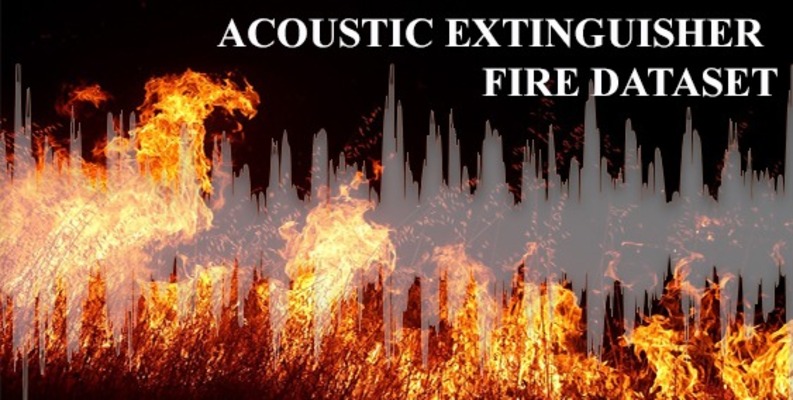 Acoustic Extinguisher Fire Dataset
Acoustic Extinguisher Fire Dataset
Acoustic Extinguisher Fire Dataset
 Acoustic Extinguisher Fire Dataset
Acoustic Extinguisher Fire Dataset
The dataset was obtained as a result of the extinguishing tests of four different fuel flames with a sound wave extinguishing system. The sound wave fire-extinguishing system consists of 4 subwoofers with a total power of 4,000 Watt placed in the collimator cabinet. There are two amplifiers that enable the sound come to these subwoofers as boosted. Power supply that powers the system and filter circuit ensuring that the sound frequencies are properly transmitted to the system is located within the control unit. While computer is used as frequency source, anemometer was used to measure the airflow resulted from sound waves during the extinguishing phase of the flame, and a decibel meter to measure the sound intensity. An infrared thermometer was used to measure the temperature of the flame and the fuel can, and a camera is installed to detect the extinction time of the flame. A total of 17,442 tests were conducted with this experimental setup. The experiments are planned as follows:
KEYWORDS: Fire, Extinguishing System, Sound wave, Machine learning, Fire safety, Low frequency, Acoustic
Data properties and descriptions for liquid fuels
FEATURES MIN/MAX VALUES UNIT DESCRIPTIONS
SIZE 7, 12, 14, 16, 20 cm Recorded as 7 cm=1, 12 cm=2, 14 cm=3, 16 cm=4, 20 cm=5
FUEL Gasoline, Kerosene, Thinner Fuel type
DISTANCE 10 - 190 cm
DESIBEL 72 - 113 dB
AIRFLOW 0 - 17 m/s
FREQUENCY 1-75 Hz
STATUS 0, 1 0 indicates the non-extinction state, 1 indicates the extinction state
Data properties and descriptions for LPG
FEATURES MIN/MAX VALUES UNIT DESCRIPTIONS
SIZE Half throttle setting, Full throttle setting Reocerded as Half throttle setting=6, Full throttle setting=7
FUEL LPG Fuel type
DISTANCE 10 - 190 cm
DESIBEL 72 - 113 dB
AIRFLOW 0 - 17 m/s
FREQUENCY 1-75 Hz
STATUS 0, 1 0 indicates the non-extinction state, 1 indicates the extinction state
** KOKLU M., TASPINAR Y.S., (2021). Determining the Extinguishing Status of Fuel Flames With Sound Wave by Machine Learning Methods. IEEE Access, 9, pp.86207-86216, Doi: 10.1109/ACCESS.2021.3088612 Link: https://ieeexplore.ieee.org/document/9452168 (Open Access) https://ieeexplore.ieee.org/stamp/stamp.jsp?tp=&arnumber=9452168
** TASPINAR Y.S., KOKLU M., ALTIN M., (2021). Classification of Flame Extinction Based on Acoustic Oscillations using Artificial Intelligence Methods. Case Studies in Thermal Engineering, 28, 101561, Doi: 10.1016/j.csite.2021.101561 Link: https://www.sciencedirect.com/science/article/pii/S2214157X21007243 (Open Access)
** TASPINAR Y.S., KOKLU M., ALTIN M., (2022). Acoustic-Driven Airflow Flame Extinguishing System Design and Analysis of Capabilities of Low Frequency in Different Fuels. Fire Technology, Doi: 10.1007/s10694-021-01208-9 Link: https://link.springer.com/content/pdf/10.1007/s10694-021-01208-9.pdf"